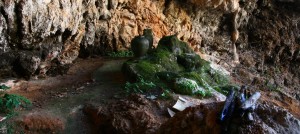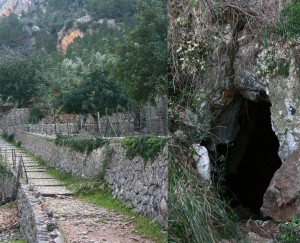The valley of Sóller,since time immemorial, has been a great attraction for all the cultures that have resided in our island, being a fertile valley, with plenty of water and a large natural harbour (the largest in the north coast). Prehistoric Talayotic, Greeks, Phoenicians, Romans and Muslims have left, in Soller, fossilized footprint in the form of archaeological sites, places where they lived and where they died. Soller is one of the towns of Majorca that has more archaeological sites, reflecting that it was inhabited over the centuries. But one of the archaeological remains that are more unknown are roads, yes roads. Although today the roads of the Serra de Tramuntana (GR 221)are used by the hikers, these were originally communication paths between different prehistoric people around us.
Ravine road and entrance to the cave s’Alova.
If we have to highlight one of these routes, this would be the Biniaraix ravine. This impressive geological formation not only impresses us, but also our ancestors were impressed by its beauty and it was endowed to a symbolic and religious value. The Biniaraix ravine was the main route of communication of the valley with the Serra de Tramuntana. The fact of being such a rugged and inaccessible place made that the local “mallorquines” related this road as a connection between life and death, this is reflected by the presence of a large number of caves where they buried their dead . S’Alova cave is remarkable for its size and importance, since it is known that there was buried the elite of the most important prehistoric settlement in the valley. In addition to this cave we must emphasize the cave of Ses Alfàbies(jars), where from the immemorial time water was collected with these large containers falling water drop by drop, by the stalactites. Today you can still see some of them.

Currently the Biniaraix ravine path is divided into two, the main road and the old road, the second was used by our ancestors as the main road was built in the sixteenth century, when the use of gunpowder allowed to open another route between the hard limestone. So it is advisable to visit this stretch of road in order to keep the footprint of the old Mallorcan.
